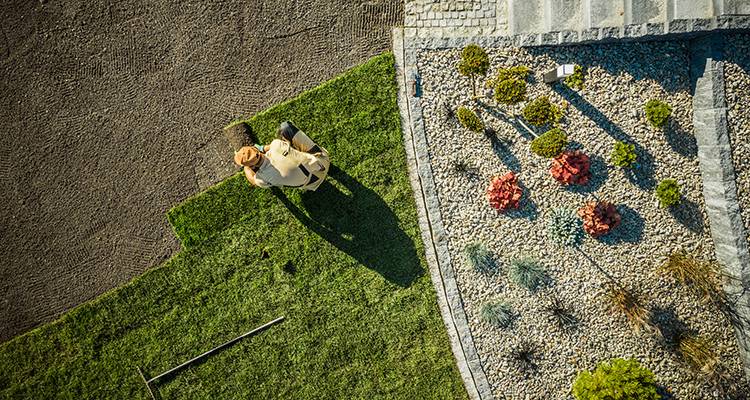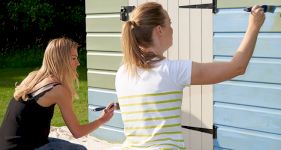Decking Installation Guide
If you want to install garden decking, there are a few things to bear in mind.
We will look at the different types of decking that are available, as well as various design ideas to incorporate into your garden. The time that it will take to lay your decking boards will depend on the design and decking materials that you choose and how much of your garden you cover.
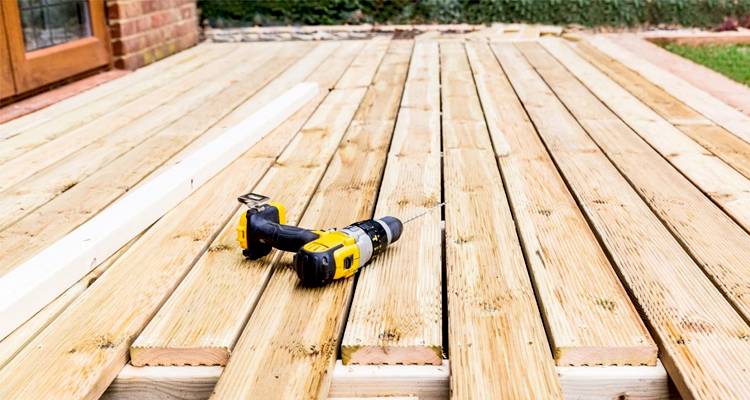
Table of Contents
- What is Decking?
- Types of Decking
- Garden Decking Ideas
- What Are the Pros and Cons of Decking?
- How Much Does Garden Decking Cost?
- How to Install Decking
- How Long Does It Take to Install Decking?
- Building Regulations or Planning Permission Approval for Garden Decking
- How to Clean and Maintain Decking
- Alternatives to Garden Decking
- Questions to Ask When Hiring a Decking Installer
- FAQs
- Sources
What is Decking?
A garden deck is a raised platform or terrace attached to a house or other building. It is a good way to define different parts of the outside space. A garden deck can extend the indoors to the outdoors in a practical way, often leading to the lawn or the rest of the garden.
Although this is the traditional and original definition of decking, there are various designs and ways of installing a garden deck. The popularity of decking in the last couple of decades has also seen an evolution of the way it is used in the garden.
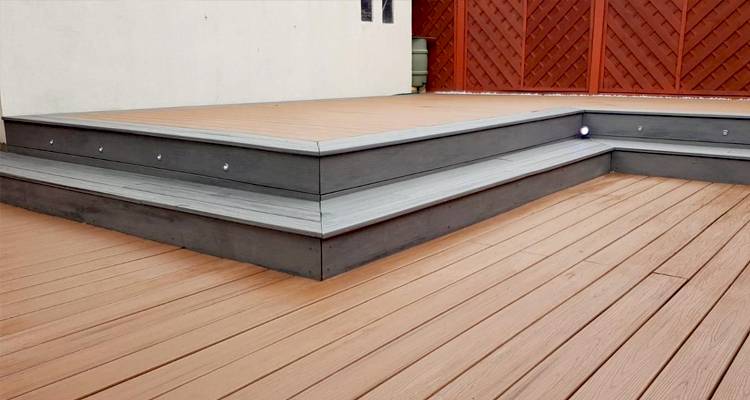
No longer does it have to be directly attached to the house and often is seen as a standalone feature in a quiet corner of the garden away from the hustle and bustle of the home.
One of the original benefits of decking was removing the need to mow the lawn, with the decking taking up a large part of the grassed areas of the garden. There has been a move back to reinstating lawns in recent years, but garden decking remains a desirable element of many homes. This is obvious in the number of different decking materials and the various designs that are available today.
Garden decking can also be installed in sloping gardens, thereby providing a level and stable seating area that would otherwise not have been possible. Decking installation is also popular around hot tubs and above ground pools.
Types of Decking
There are many decking variations available in a range of materials, including timber, composite material, PVC, and plastic. Timber decking comes in softwood and hardwood varieties also.
Timber Decking
Timber decking was the first popular type to be used and is still very widely used today. The natural look and feel of wood appeals to most people as a material to be used in the garden, so installing timber decking is a good choice.
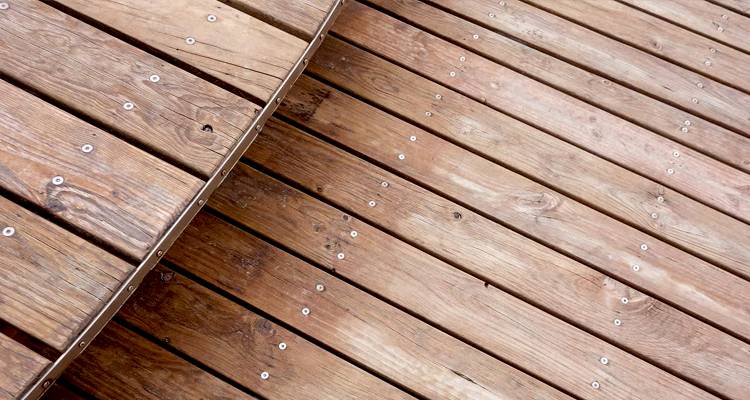
One of the first considerations for most people when contemplating a large project is their budget. When deciding on a type of timber decking, this will be a factor as there are different quality timbers available such as pine, larch, cedar or iroko, amongst others which will vary in price.
PROS
✔ It looks and feels natural as part of the structure of the garden
✔ Many timber decking materials will last 15-20 years
✔ Lots of choice with types of wood and designs
CONS
✖ Some types of timber decking can be very expensive, up to £500 per square metre
✖ Most timber decking materials will need regular treatment with wood preservative
✖ It can become slippery with moss and algae growth
Composite Decking
There are different types of composite decking, so the one you choose will influence how much you pay for your garden decking and how long it is likely to last.
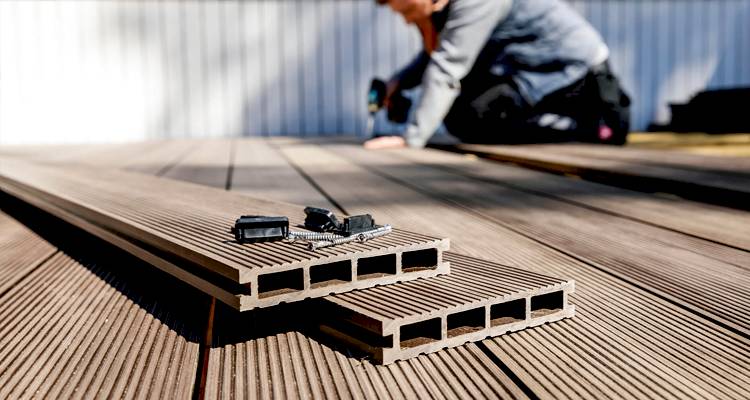
Composite decking such as Trex decking is made from a mixture of wood and synthetic materials. This combination gives the appearance of timber with the strength of synthetic materials that will ensure the decking lasts much longer than wood alone.
Installing composite decking is similar to timber decking installation, with the fixing being slightly different.
PROS
✔ Much longer life than timber decking
✔ It comes in a range of different qualities and prices
✔ Resists the factors which make timber decking so slippery
CONS
✖ Although it may look like timber decking, it will not have the same aesthetic appeal
✖ It can be as expensive as timber without the benefits of wood
✖ The cheaper ranges are not particularly strong
PVC Decking
While PVC decking is sometimes confused with composite decking boards, there are some important differences. Composite means there is more than one material involved in producing decking, i.e., wood and synthetic fibres.
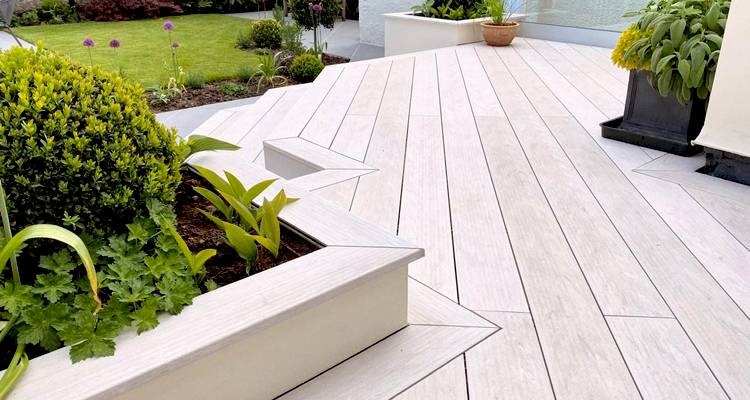
On the other hand, PVC decking is made purely from polyvinyl chloride hence 'PVC' with no other materials mixed in.
PVC is a material that is typically associated with long-lasting products such as windows and doors. While this is the case in most instances, decking is a different product. PVC decking such as Azek decking can be uncapped or capped, which means it is given extra strength and protection against UV rays.
PROS
✔ Resistance to algae and mould growth
✔ It doesn't require regular maintenance, unlike timber
✔ Recyclable product
CONS
✖ Expands under prolonged exposure to direct sunlight
✖ It can get very warm underfoot in hot weather, making it uncomfortable on bare feet
✖ It does not have the same visual appeal as timber decking
Which is the Best Decking?
Deciding which is the best decking is a purely personal choice as people's preferences and tastes vary. For those who want to maintain a natural feeling in the garden, timber decking will be their first choice, but for some, the maintenance is too high, so they may opt for composite decking.
Garden decking costs will be a contributing factor when deciding which decking to have. Hardwood such as Ipe decking is one of the most expensive, while softwood is a lot cheaper. However, there are many different types, so if you decide to install timber decking, you will have many choices to suit your budget.
Deciding on a type of decking will also be influenced by how much maintenance you want to put into it. Softwood timber decking is one of the most high maintenance materials and needs regular treatment with preservatives to keep it from degrading.
Hardwood decking is very resistant to rot, and insect attack and Ipe decking can last more than twenty years without preservative.
For low maintenance, the best decking boards are composite or PVC decking. Typically, any type of plastic decking will not require treatment, so it is a good option if you don't want to spend too much time or money maintaining the decking.
If you want the decking to last, you could invest in hardwood decking, but this does not come cheap. For durability, composite decking boards will last a long time and have the added benefit of not requiring regular treatment. While it may be slightly more expensive, installing composite decking will cost very little in terms of maintenance but will not need to be replaced for many years.
Garden Decking Ideas
When considering different ideas for your garden decking, perhaps the first thought should be what the decking will be used for and how often.
Outdoor Dining
Decking that is attached to the house is typically used as an outdoor dining area and also a great place to relax and socialise in the nice weather. There is a huge amount of outdoor furniture that can look great on your deck and provide an extension to the living space of the house. A pergola or free-standing parasols can give shade on warm days.
Landscaping
The cost of installing decking could also be part of a larger landscaping project of your garden. You may want to fit something with visual appeal, making it a focal point of your garden. Some people install decking to surround a hot tub or above ground pool or simply as a quiet place in the garden for chilling out or reading.
Alternative to Lawn or Patio
Fitting decking can be an alternative to a patio or lawn. The benefit of a deck is that it can be raised above the ground and potentially make the most of surrounding views. A deck that replaces a lawn also removes the need to mow the lawn, which can be an incentive for those who are too busy for gardening.
Using Unusable Space
If part of your garden is unusable because it is sloping or uneven, this could be a perfect case to fit a deck or even multi-level decking. As the decking needs to be a raised platform, adjustments can be made so that it can be situated where a patio or lawn would not work.
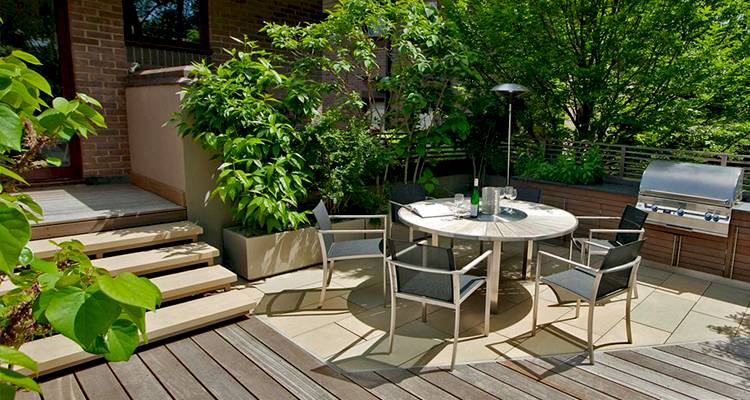
What Are the Pros and Cons of Decking?
The decision to lay decking will require some thought, so you need to consider the advantages and disadvantages before proceeding.
Pros of Decking
There are many benefits to fitting a garden deck, including space for outdoor living, improving the look of your garden as well as adding to its attractiveness if you intend to sell.
Additional Space
The cost of installing decking may be offset by gaining additional outdoor living space. This space can be used for dining, relaxing, socialising or for children to play safely. Decking can be installed adjacent to the house or as a separate quiet area in the garden.
Improves the Look of the Garden
A well-constructed deck area can add aesthetic appeal and interest to a garden. This is particularly the case if the deck has made use of an area of the garden that would otherwise not be used, like a steep slope or uneven ground.
Selling Appeal
Adding to the functionality of a property will invariably add to its value, especially as a family home. With decking already in place, if you are selling your home, you will be adding to the resale appeal of the house.
Versatility
There are so many designs and types of decking materials available, meaning that it is a very versatile addition to your garden and home.
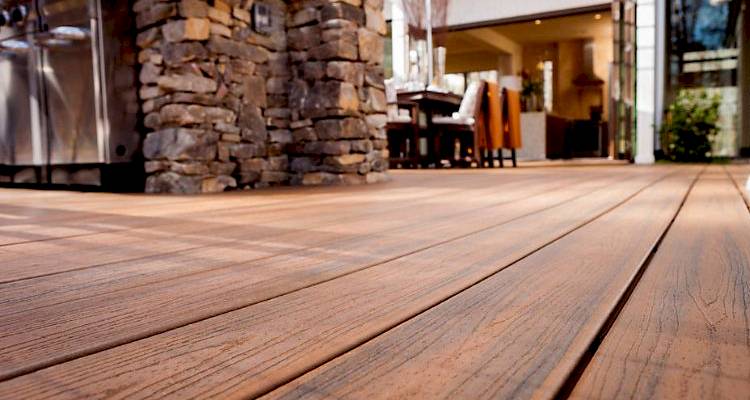
Cons of Decking
Despite the many advantages of fitting a garden deck, there are also a few downsides, some of which may not be readily apparent.
Loss of Grass Areas
Covering areas of grass and soil can do environmental damage that we don't immediately consider. A loss of drainage can add to the growing problem of local flooding, with more green spaces being paved over, there is nowhere for the water to go.
Impact on Wildlife
Removing parts of your garden to install decking has other environmental disadvantages, such as the loss of habitat for local wildlife such as hedgehogs, birds or insects.
Adding to Landfill
Not all decking will be recyclable, and this will add to the landfill when the time comes to remove or replace it. Most timber decking will degrade over time, but many composite decking boards and plastic decking cannot be recycled.
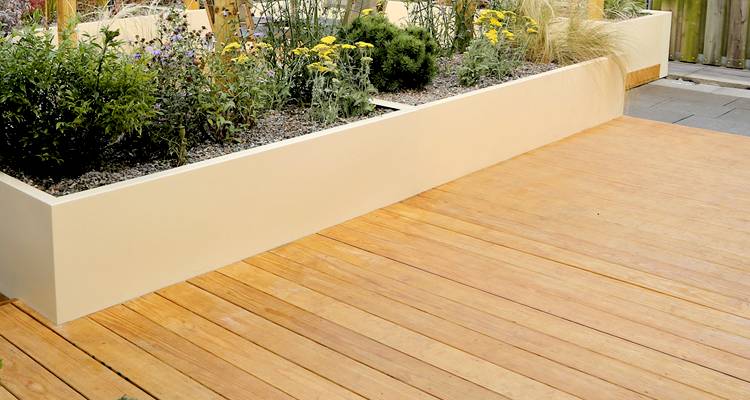
How Much Does Garden Decking Cost?
Decking installation costs will be affected by the type of decking material as well as the size of the deck that you want to install.
Type of Decking Material
Timber decking can be either softwood or hardwood, with the softwood typically being treated with a preservative. This is one of the cheapest types of decking and costs on average £3-£6 per square metre.
Hardwood is much more expensive and will typically cost between £4-£10 per square metre. Ipe decking is an especially durable hardwood that can last decades without preservative, and this will cost around £8-£15 per square metre.
Trex decking is a composite type of decking made from wood fibres and plastic coating. It is a resilient and durable form of decking material and will cost between £6-£15 per square metre. Plastic decking is durable, and while not as strong as composite, it is cheaper, costing £5-£10 per square metre.
Size of Deck
The amount of decking required will also affect the decking installation prices. A small deck of around 15 square metres will range from £1,000 for softwood decking and up to £2,500 for Ipe hardwood decking. Composite and plastic decking range between £800-£2,000 for the same size area.
A medium deck of 30 square metres will cost between £1,200-£4,750 depending on the chosen decking material. Decking installation costs for a large deck of 60 square metres will be approximately £1,600 to almost £7,000.
Additional Costs
As well as the cost of laying the decking, there are other related expenses such as staining and regular maintenance of the decking as well as the rest of the garden. You may also have other jobs that need to be done, such as fixing a fence or removing an old garden shed as part of a general garden makeover.
Deck Staining
If you need to stain your decking, the cost will depend on the type of stain you use and the amount required to cover the whole deck. The average cost of staining a deck will be around £10 per square metre.
Fencing
Fencing is a fundamental part of most British gardens, and they are one of those features that require regular maintenance and occasionally need to be fixed or replaced. The cost of installing new fencing is approximately £1,000.
Garden Maintenance
The average cost of garden maintenance services will vary according to where in the country you live but ranges between £14-£25 per hour. Costs will also depend on the size of the garden and how much work is involved.
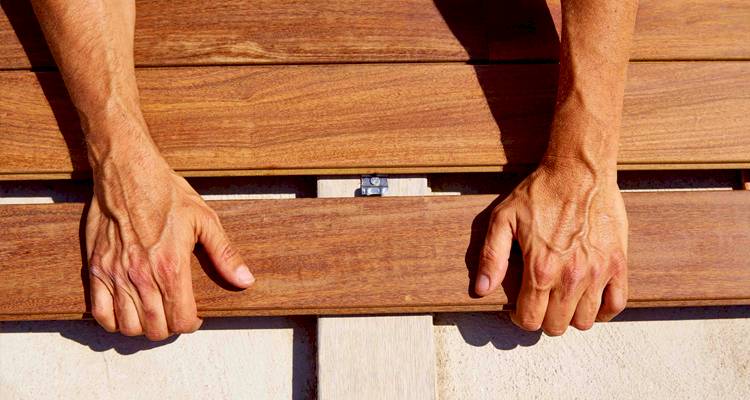
How to Install Decking
Whether you intend to install decking as a DIY project or hire a contractor, it is good to know what is involved from start to finish.
Preparation
Before any physical work is done to fit your garden deck, you need to decide where it will be located. The vast majority of decking is fitted adjacent to the house, but there is also a trend for 'island' decking, which means it is not connected to the house or any other building.
When the location is decided, the ground will need to be prepared with any obstructions or debris removed, and a weed suppressant should also be installed.
Installation Process
The support posts for the decking should be dug in and set in concrete. If the decking is attached to the house, a waterproof flashing should be fitted to protect against water ingress and subsequent damage.
The deck's frame is then built consisting of joists, support beams and noggins, all of which are attached to the support posts. The decking boards are laid in the desired orientation on the frame and fixed into place with either nails or screws.
If you have a balustrade around the deck, this will then be installed along with any steps required for access.
Finishing Off
Timber decking will then be stained or sealed if appropriate. Composite boards such as Trex decking do not require this step. You can then furnish the deck and add decorative features such as plant pots or lighting.
DIY or Contractor
Fitting a garden deck is a relatively easy job for someone confident in their DIY skills. Decking installation prices without the need to include labour costs can save you between £20-£50 per square metre.
However, it needs to be stressed that there are dangers associated with any DIY job. The risk of injury, especially when working with power tools, should be borne in mind. There is also the danger of crush injury when handling heavy timber or even a strained back if you don't enlist help with lifting and carrying.
Doing a deck installation as a DIY job may mean that the structure is not as solid or secure than if a professional fitted it. This might cause injury if the structure were to collapse.
How Long Does It Take to Install Decking?
The timeframe to install decking will depend on the size of the deck, the material used, and the number of people working on it.
Timber Decking Timeframes
The size of a timber deck installation will dictate how long it will take to complete. If there is a lot of debris to remove or excavation to be done, this can add a whole day to the process.
Typically, a timber deck of 15 square metres can be done in a day to day and a half. A larger deck of 30 square metres can take 2-3 days, while a 60 square metre deck may take 3-4 days.
Composite Decking Timeframes
This type of decking varies according to the manufacturer, and some installation processes will differ. There are three basic types of composite decking, e.g., uncapped hollow boards, uncapped solid core boards, and capped solid core boards.
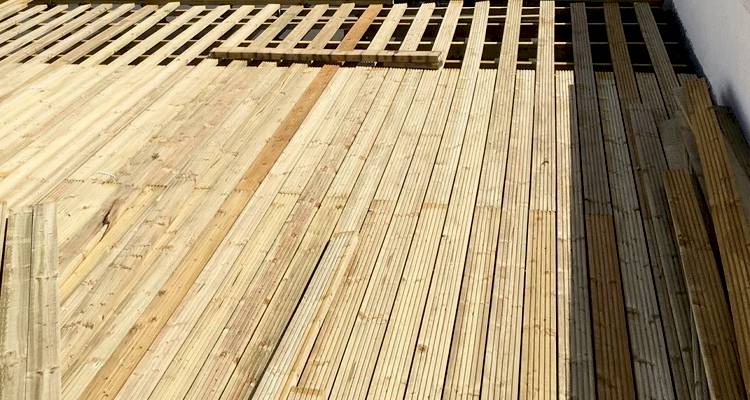
Each of these has a slightly different method of fixing, so the timeframes for each will vary. A small deck may take a day, with larger areas taking 2-3 days, depending on the design.
Building Regulations or Planning Permission Approval for Garden Decking
You may wonder if you wish to install a garden deck whether you need to apply for planning permission or if it is necessary to comply with Building Regulations.
Building Regulations
There are no particular Building Regulations that need to be adhered to for the fitting of a garden deck and no fee to be paid to building control.
Planning Permission
You will not normally need planning permission to install decking if the area does not exceed 50% of the garden, is no more than 30cm off the ground and not forward of the principal elevation of the house.
Properties that are listed, in conservation or other designated areas may be subject to some restrictions. So, it is best to check with the planning department of your local authority before starting work on your garden deck.
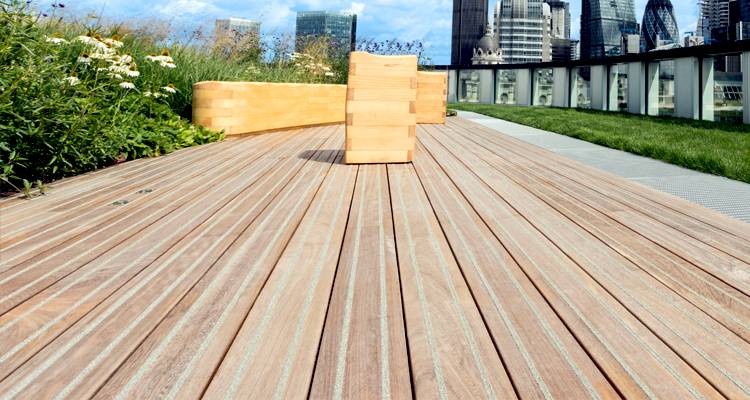
Information on planning permission for decking is available on the Planning Portal. If you do require planning permission, the cost will be around £200.
If you install decking that affects a party wall with your neighbour, you will need to inform them of the works. All relevant information about party wall issues is available on the government website.
How to Clean and Maintain Decking
To maximise your investment, you should carry out regular cleaning and maintenance on your decking. However, as decking can be made from lots of different materials, the method and frequency of this maintenance and cleaning will vary.
Sweeping
Decking should be swept regularly with an appropriate bristle brush according to the material. Removing dirt, debris, leaves and twigs from the decking surface will keep it clean, reduce the amount of algae and mould that will grow on it and keep it looking good.
Washing
A power washer on a low setting can be good for cleaning a garden deck and removing dirt and algae growth. Care should be taken with timber decking as it can be damaging to the wood preservative if the power washer is set too high.
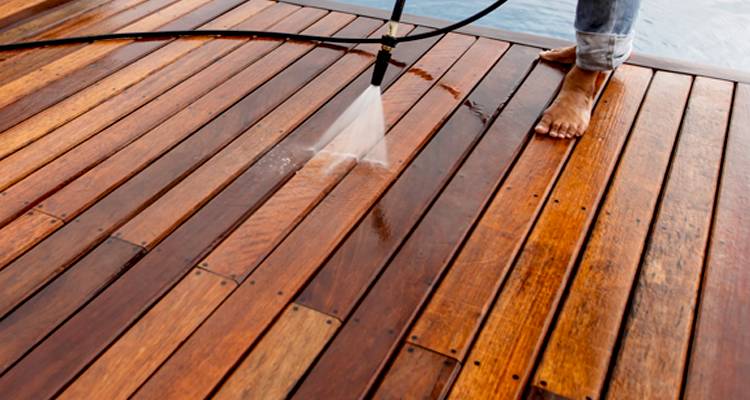
A deck brush and some soapy water may be a more gentle cleaning solution if you are concerned about using a power washer. Composite and PVC decking such as Azek decking can be cleaned either way.
Treating
After cleaning a timber deck, you can reapply a new coat of preservative, stain, or deck oil to maintain the condition of the wood. Composite decking will have appropriate products for treating to enhance the look of the decking boards and preserve them.
The best stain or paint for your decking will depend on your deck's material, and recommendations from the manufacturer should be followed.
Alternatives to Garden Decking
If you decide that decking is not for you, then there are alternatives, whether you are carrying out a makeover of your garden or just buying a house and deciding on the garden design.
Paving
Patios are still very popular, and there are many different styles and designs to choose from, such as brick, concrete, slate, or stone.
The cost of laying a patio can be as low as £550 for a small brick area or almost £4,000 for a large, slate patio. The amount of excavation needed, the complexity of the design and the area you live in will all affect the cost of laying a patio.
Artificial Grass
If the thought of weekly mowing in the summer is too much of a chore, then you might want to consider installing artificial grass.
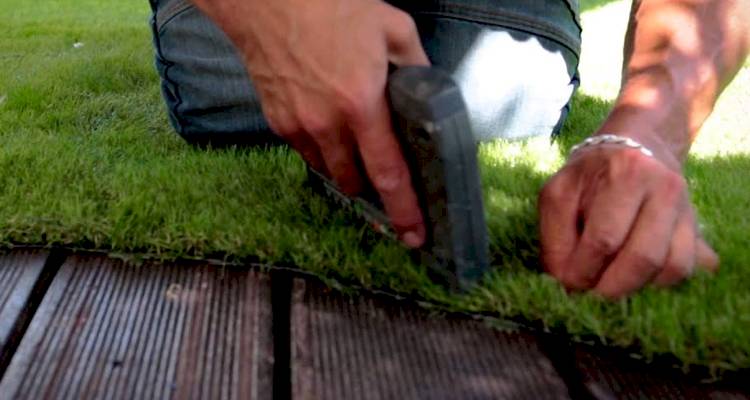
You will retain the look of grass without the need to cut it, although artificial grass will need some maintenance such as rinsing with a hose or removing debris such as leaves or twigs.
The cost to install artificial grass in a medium-sized garden is around £2,000.
Turf
A lot of people prefer real grass despite the work involved in maintaining it. In fact, some people who have had decking have removed it and returned the garden to grass.
Laying turf will cost around £15 per square metre, although this will depend on the quality of the turf, the area that you live in and whether or not you need additional topsoil.
Most homebuyers will probably prefer to see a grass lawn as this can be built on if desired or left as it is. If there is a deck or patio in place, then depending on the homebuyer's taste, this may put them off when considering the work to remove it.
Questions to Ask When Hiring a Decking Installer
When considering the installation of garden decking and hiring a professional contractor, there are a few things to bear in mind.
- Make sure you speak to more than one decking installer to get a feel for the process, how long it will take and an average cost.
- When looking at decking installation prices, make sure that you understand what is included and what isn't, for example, clearing the site and excavating the ground.
- Ask for photos or visits to see examples of previous similar jobs.
- Ensure that your contractor has the appropriate insurance for the work that they will be doing and ask for proof of this.
- It is good to have a written agreement about the work to be carried, the cost and the payment terms, so there is no confusion.
FAQs
How do you clean composite decking?
Depending on the type of composite decking and the manufacturer's recommendations, specific methods and cleaning materials can be used. Power washers should be used with caution as if operated on full power, they can damage the decking.
How do you build decking stairs?
The risers should be joined together top and bottom, and the framework attached to the deck in the required position. The treads can now be fixed in place on the risers. A low set of steps will not typically need a handrail, but a higher one may, and this can be added if needed.
Can you have a garden deck on sloping ground?
By installing supports that are higher on one end of the decking, it is possible to have a level and stable platform to fit your decking to. This is most likely a job best left to a professional and experienced decking installer, however.
How do you avoid slippery decking?
Of course, frost and ice can form overnight and make a deck surface dangerous, but there are non-slip decking materials, so these could be installed to make the decking safe in all seasons.
What's the difference between hardwood and softwood decking?
Not all hardwoods are suitable for decking, but some are. Timber decking such as Ipe is ideal, as it is an exotic hardwood that lasts for more than twenty years without preservative.
Sources
https://ultradecking.co.uk/what-is-pvc-decking-made-up-of/
https://teckwood.co.uk/pvc-plastic-decking-what-is-it-and-should-i-use-it/
https://www.trex.com/why-trex/composite-vs-plastic-decking
https://azekco.com/
https://www.planningportal.co.uk/info/200130/common_projects/11/decking
https://www.londondeckingcompany.co.uk/
https://www.tdca.org.uk/


